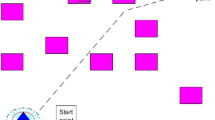This paper presents the planning of a near-optimum path and location of a workpiece by genetic algorithms. The purpose of this planning is to minimize the processing time required for a robot to complete its work on a workpiece. The location of the workpiece can be anywhere by translating it along any direction and by rotating it about the fixedz-axis of the robot coordinate system. Owing to the changeable location of the workpiece and the alterable motion time required for a robot to move between two workpoints, the path and location planning problem is much more complicated than the travelling salesman problem. It is definitely impossible to obtain an optimum path and location within an acceptable time. In this paper, genetic algorithms are applied to solve this problem. The location of the workpiece is defined by three position parameters and one angular parameter, and the path is determined based on the values of the parameters for all workpoints. All the path and location parameters are encoded into a binary string. They are modified simultaneously by genetic algorithms to search for a global solution. As the workpiece can be anywhere, a penalty function is used to prevent the selection of illegal paths. Two experiments are given to show the performance of genetic algorithms: one has 30 workpoints and the other has 50 workpoints. Compared with four human-generated plannings, planning by genetic algorithms has much better performance in minimizing the processing time.
Similar content being viewed by others
References
Baker, J. E. (1985) Adaptive selection methods for genetic algorithms, inProceedings of the International Conference on Genetic Algorithms and their Applications, Hillsdale, NJ, pp. 101–111.
Davis, L. (1985) Job shop scheduling with genetic algorithms, inProceedings of the International Conference on Genetic Algorithms and their Applications, Hillsdale, NJ, pp. 136–140.
Dejong, K. A. and Spears, W. M. (1989) Using genetic algorithms to solve NP-complete problem, inProceedings of the International Conference on Genetic Algorithms and their Applications, San Mateo, CA.
Fox, B. R. and McMahon, M. B. (1991) Genetic operators for sequencing problems, inFoundations of Genetic Algorithms, Rawlins, G. J. E. (ed.), Morgan Kaufmann Publishers, New York.
Goldberg, D. E. (1989)Genetic Algorithms in Search, Optimization and Machine Learning, Addison-Wesley, New York.
Goldberg, D. E. and Lingle, R. (1985) Alleles, loci, and the traveling salesman problem, inProceedings of the International Conference on Genetic Algorithms and their Applications, Hillsdale, NJ, pp. 154–159.
Grefenstette, J. J., Gopal, R., Rosmaita, B. J. and Van Gucht, D. (1985) Genetic algorithms for the traveling salesman problem, inProceedings of the International Conference on Genetic Algorithms and their Applications, Hillsdale, NJ, pp. 160–168.
Holland, J. H. (1975)Adaptation in Natural and Artificial Systems, University of Michigan Press, Ann Arbor, MI.
Hopfield, J. J. and Tank, D. W. (1985) Neural computation of decisions in optimization problems.Biological Cybernetics,5(8), 63–70.
Maimon, O. (1990) The robot task-sequencing planning problem.IEEE Transactions on Robotics and Automation,6(6), 760–765.
Oliver, I. M., Smith, D. J. and Holland, J. R. C. (1987) A study of permutation crossover operators on the traveling salesman problem, inProceedings of the International Conference on Genetic Algorithms and their Applications, Cambridge, MA, pp. 224–230.
Syswerda, G. (1989) Uniform crossover in genetic algorithm, inProceedings of the International Conference on Genetic Algorithms and their Applications, San Mateo, CA, pp. 2–9.
Whitley, D. (1989) The GENITOR algorithm and selection pressure: why rank-based allocation of reproductive trials is best, inProceedings of the International Conference on Genetic Algorithms and their Applications, San Mateo, CA, pp. 116–121.
Yural, D. (1990)Genetic Algorithms and Robots: A Heuristic Strategy for Optimization, World Scientific, New Jersey.
Author information
Authors and Affiliations
Rights and permissions
About this article
Cite this article
Chen, CJ., Tseng, CS. The path and location planning of workpieces by genetic algorithms. J Intell Manuf 7, 69–76 (1996). https://doi.org/10.1007/BF00114139
Issue Date:
DOI: https://doi.org/10.1007/BF00114139




